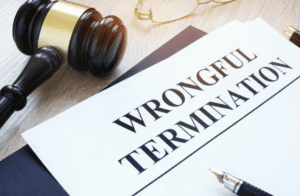 Retaliation is when an employer takes an adverse employment action—firing, demoting, creating a hostile work environment, etc.—toward you in response to your claim of discrimination or because of your participation in a discrimination hearing. This includes activity that you take on behalf of others who are discriminated against. Interestingly, according to the Equal Employment Opportunity Commission (EEOC), retaliation is “the most frequently alleged basis of discrimination in the federal sector and the most common discrimination finding in federal sector cases.” And in fiscal year 2014, the EEOC reported that charges of retaliation had reached their highest total ever at 42.8%, with race discrimination following (at 35%) as the second most common allegation received by the EEOC. Retaliation is very common—so common that you may even be facing it yourself. But how do you go about actually proving retaliation in the workplace?
Retaliation is when an employer takes an adverse employment action—firing, demoting, creating a hostile work environment, etc.—toward you in response to your claim of discrimination or because of your participation in a discrimination hearing. This includes activity that you take on behalf of others who are discriminated against. Interestingly, according to the Equal Employment Opportunity Commission (EEOC), retaliation is “the most frequently alleged basis of discrimination in the federal sector and the most common discrimination finding in federal sector cases.” And in fiscal year 2014, the EEOC reported that charges of retaliation had reached their highest total ever at 42.8%, with race discrimination following (at 35%) as the second most common allegation received by the EEOC. Retaliation is very common—so common that you may even be facing it yourself. But how do you go about actually proving retaliation in the workplace?
If you have been or are being retaliated against in your place of employment, you may be wondering what your options are and how you can prove your case. Here is what you need to know and how you can respond to fight back against illegal retaliation practices.
Table of Contents
ToggleThree Things to Prove
To establish a retaliation case, you must first show that three things are true:
- You took part in a protected activity or you witnessed illegal discrimination or harassment and reported it.
- Your employer took an adverse job action against you: that is, it fired you, demoted you, denied you a promotion, or created a hostile work environment.
- There is a link between the adverse job action and the protected activity you engaged in.
A protected activity can be either an opposition to a practice or the participation in a discrimination hearing. It can also include the failure to provide reasonable accommodation to a disabled employee.
Opposition is when an employer is informed by you, the employee, that you believe your company is discriminating against you or another employee. Examples would be an employee who is threatening to file a formal claim of discrimination, an employee who is picketing against discriminatory practices, or an employee who is refusing to follow his or her employer’s requests because the employee believes them to be discriminatory in nature.
Participation is when an employee takes part in an employment discrimination proceeding. An employer is not allowed to retaliate against an employee simply for cooperating with an investigation or serving as a witness in a case.
Gathering the Evidence
To prove the above three actions took place and were related, meaning your participation in the protected activity resulted in the adverse job action, you need evidence. This can be the challenging part in many cases because employers almost never admit to the wrongdoing. And it can often be difficult to find “smoking gun” evidence that your employer is intentionally retaliating against you (though you’d be surprised what some employers will say in e-mail). As such, most retaliation and employment law cases rely on circumstantial evidence to prove a causal connection. The more circumstantial evidence employees have, the stronger their case will be. Examples of circumstantial evidence could be a pattern of adverse actions toward other employees who made similar complaints or evidence that employees who did not complain received better treatment. Another common example of circumstantial evidence is when an employee suddenly starts to receive poor performance reviews after raising issues of discrimination.
“But For” Causation
Causation can be the most difficult part of the puzzle to prove. How does one prove the internal motives of another? In 2013, the U.S. Supreme Court made it even harder with its landmark ruling requiring employees to establish a “but for” cause to support a claim of retaliation. In other words, the employee has to prove that the harm or adverse job action would not have occurred in the absence of the employee’s participation in the protected activity. This can be difficult because in many cases employers can point to a number of different legal factors as reasons for the adverse job action, such as poor performance or restructuring.
An example of how hard proving retaliation in the workplace can be is the case Frederick v. New Hampshire. Frederick sued her former employer after being let go seven weeks after her FMLA leave ended. Frederick claimed that her employer did not fairly accommodate her need to breastfeed her son, and when she complained about it, she was fired. While Frederick was able to prove that she had suffered an adverse job action and took part in a protected activity, she failed to convince the court that there was a causal connection between the two and lost her case. The proximity in timing of the protected activity and the adverse job action was not enough to prove a “but for” causation.
What You Can Do
If you think you are being retaliated against, you should be sure to keep a record of every negative action and any verbal or written evidence that may relate to your case. Write everything down, even if you think it is a small, unimportant detail.
Bring up your concern with your employer, either your manager or the human resources office. Be sure you have written evidence that you have raised the issue. E-mail is a good way to do this.
Speak with a lawyer. By setting up a consultation with a lawyer, which usually lasts for about one hour, you can discuss the details of your case and get advice on the strength of your case and next steps. Your lawyer should be honest with you about whether you have a case worth moving forward with or if there is not enough evidence to prove causation.
Spiggle Law helps employees stand up for their rights and fight back against illegal employment practices. Our team of experienced lawyers can help you understand the nuances of the law as they apply to your case and how you can go about proving retaliation in the workplace. Should you decide to pursue a case, we will act as your advocates and advisers from the initial consultation to the final settlement. Contact us to learn more about our team and to schedule a consultation.





